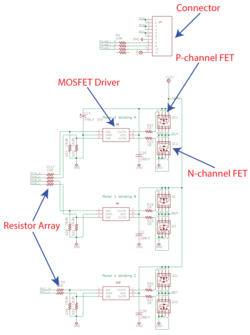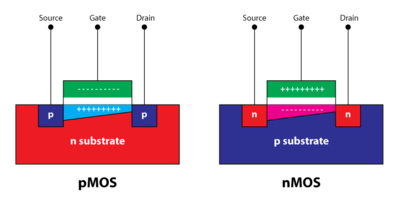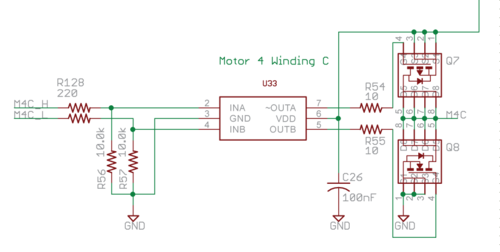Difference between revisions of "RoboCup: Control Board 2011"
| Line 2: | Line 2: | ||
|year=2013 | |year=2013 | ||
|control_ver=2011 Rev c | |control_ver=2011 Rev c | ||
| − | |mcu=[http://www.atmel.com/images/doc6175.pdf AT91SAM7S256] | + | |mcu=Atmel [http://www.atmel.com/images/doc6175.pdf AT91SAM7S256] |
| + | |fpga=Xilinx [http://www.xilinx.com/support/index.html/content/xilinx/en/supportNav/silicon_devices/fpga/spartan-3e.html Spartan-3E] | ||
|motors=Maxon EC45flat 30W | |motors=Maxon EC45flat 30W | ||
}} | }} | ||
| Line 19: | Line 20: | ||
== Motor Operations == | == Motor Operations == | ||
| − | [[File:RC EE three phase bridge 2011 c.png|thumb|left|250px]] | + | [[File:RC EE three phase bridge 2011 c.png|thumb|left|250px|RC EE three phase bridge 2011 c.png]] |
| Line 42: | Line 43: | ||
| − | [[File:RC EE Motor Winding.png|thumb|500px]] | + | [[File:RC EE Motor Winding.png|thumb|500px|RC EE Motor Winding.png]] |
=== Debugging === | === Debugging === | ||
| Line 50: | Line 51: | ||
=== Other Websites/Resources === | === Other Websites/Resources === | ||
| − | *Youtube video explaining the operations of brushless DC motors (BLDC) - [http://www.youtube.com/watch?v=ZAY5JInyHXY | + | *Youtube video explaining the operations of brushless DC motors (BLDC) - [http://www.youtube.com/watch?v=ZAY5JInyHXY|youtube.com [1]] |
| − | *PDF about more BLDC motors - [http://electrathonoftampabay.org/www/Documents/Motors/Brushless | + | *PDF about more BLDC motors - [http://electrathonoftampabay.org/www/Documents/Motors/Brushless DC (BLDC) Motor Fundamentals.pdf|electrathonoftampabay.org [2]] |
<!-- POWER OPERATIONS --> | <!-- POWER OPERATIONS --> | ||
| Line 349: | Line 350: | ||
| J10 | | J10 | ||
| 6 pins, 2mm pitch, right angle | | 6 pins, 2mm pitch, right angle | ||
| − | | [http://www.mouser.com/ProductDetail/Molex/35363-0660/?qs= | + | | [http://www.mouser.com/ProductDetail/Molex/35363-0660/?qs=/ha2pyFadujBOZ1JGwzODo9s6IhbRgLmbKFlMuRfet72D1vzVyKatg== http://www.mouser.com/ProductDetail/Molex/35363-0660/?qs=%2fha2pyFadujBOZ1JGwzODo9s6IhbRgLmbKFlMuRfet72D1vzVyKatg%3d%3d] |
| [http://www.molex.com/webdocs/datasheets/pdf/en-us/0353630660_PCB_HEADERS.pdf http://www.molex.com/webdocs/datasheets/pdf/en-us/0353630660_PCB_HEADERS.pdf] | | [http://www.molex.com/webdocs/datasheets/pdf/en-us/0353630660_PCB_HEADERS.pdf http://www.molex.com/webdocs/datasheets/pdf/en-us/0353630660_PCB_HEADERS.pdf] | ||
|- | |- | ||
| Line 359: | Line 360: | ||
| J9 | | J9 | ||
| 3 pins, 2mm pitch, right angle | | 3 pins, 2mm pitch, right angle | ||
| − | | [http://www.mouser.com/ProductDetail/Molex/35363-0360/?qs= | + | | [http://www.mouser.com/ProductDetail/Molex/35363-0360/?qs=/ha2pyFaduhK4v2tb3HgRUpbM1MbxgTCgr8TLSxaq9o= http://www.mouser.com/ProductDetail/Molex/35363-0360/?qs=%2fha2pyFaduhK4v2tb3HgRUpbM1MbxgTCgr8TLSxaq9o%3d] |
| [http://www.molex.com/webdocs/datasheets/pdf/en-us/0353630360_PCB_HEADERS.pdf http://www.molex.com/webdocs/datasheets/pdf/en-us/0353630360_PCB_HEADERS.pdf] | | [http://www.molex.com/webdocs/datasheets/pdf/en-us/0353630360_PCB_HEADERS.pdf http://www.molex.com/webdocs/datasheets/pdf/en-us/0353630360_PCB_HEADERS.pdf] | ||
|- | |- | ||
| Line 369: | Line 370: | ||
| J3 | | J3 | ||
| 2 pins, 2mm pitch, right angle | | 2 pins, 2mm pitch, right angle | ||
| − | | [http://www.mouser.com/ProductDetail/Molex/35363-0260/?qs= | + | | [http://www.mouser.com/ProductDetail/Molex/35363-0260/?qs=/ha2pyFaduhyNMfBO1jMVa8dd2vEMulOKy2iGSNutHw= http://www.mouser.com/ProductDetail/Molex/35363-0260/?qs=%2fha2pyFaduhyNMfBO1jMVa8dd2vEMulOKy2iGSNutHw%3d] |
| [http://www.molex.com/webdocs/datasheets/pdf/en-us/0353630260_PCB_HEADERS.pdf http://www.molex.com/webdocs/datasheets/pdf/en-us/0353630260_PCB_HEADERS.pdf] | | [http://www.molex.com/webdocs/datasheets/pdf/en-us/0353630260_PCB_HEADERS.pdf http://www.molex.com/webdocs/datasheets/pdf/en-us/0353630260_PCB_HEADERS.pdf] | ||
|- | |- | ||
| Line 379: | Line 380: | ||
| J11, J19 | | J11, J19 | ||
| 2 pins, 3.95mm pitch, right angle | | 2 pins, 3.95mm pitch, right angle | ||
| − | | [http://www.digikey.com/product-detail/en/B2PS-VH | + | | [http://www.digikey.com/product-detail/en/B2PS-VH(LF)(SN)/455-1648-ND/926555 http://www.digikey.com/product-detail/en/B2PS-VH%28LF%29%28SN%29/455-1648-ND/926555] |
| [http://www.jst-mfg.com/product/pdf/eng/eVH.pdf http://www.jst-mfg.com/product/pdf/eng/eVH.pdf] | | [http://www.jst-mfg.com/product/pdf/eng/eVH.pdf http://www.jst-mfg.com/product/pdf/eng/eVH.pdf] | ||
|- | |- | ||
| Line 399: | Line 400: | ||
| J17 | | J17 | ||
| 8 pins, 2mm pitch, right angle | | 8 pins, 2mm pitch, right angle | ||
| − | | [http://www.mouser.com/ProductDetail/Molex/35363-0860/?qs= | + | | [http://www.mouser.com/ProductDetail/Molex/35363-0860/?qs=/ha2pyFaduiMyCNhbXdsL8gpN6EJXiXRGlv4zydAGUg= http://www.mouser.com/ProductDetail/Molex/35363-0860/?qs=%2fha2pyFaduiMyCNhbXdsL8gpN6EJXiXRGlv4zydAGUg%3d] |
| [http://www.molex.com/webdocs/datasheets/pdf/en-us/0353630860_PCB_HEADERS.pdf http://www.molex.com/webdocs/datasheets/pdf/en-us/0353630860_PCB_HEADERS.pdf] | | [http://www.molex.com/webdocs/datasheets/pdf/en-us/0353630860_PCB_HEADERS.pdf http://www.molex.com/webdocs/datasheets/pdf/en-us/0353630860_PCB_HEADERS.pdf] | ||
|- | |- | ||
| Line 409: | Line 410: | ||
| J13, J14, J15, J16 | | J13, J14, J15, J16 | ||
| 4 pins, 2mm pitch, right angle | | 4 pins, 2mm pitch, right angle | ||
| − | | [http://www.mouser.com/ProductDetail/Molex/35363-0460/?qs= | + | | [http://www.mouser.com/ProductDetail/Molex/35363-0460/?qs=/ha2pyFaduj5LMGsqqiWUQR3WhZoP6hp6wDKcJuHuLs= http://www.mouser.com/ProductDetail/Molex/35363-0460/?qs=%2fha2pyFaduj5LMGsqqiWUQR3WhZoP6hp6wDKcJuHuLs%3d] |
| [http://www.molex.com/webdocs/datasheets/pdf/en-us/0353630460_PCB_HEADERS.pdf http://www.molex.com/webdocs/datasheets/pdf/en-us/0353630460_PCB_HEADERS.pdf] | | [http://www.molex.com/webdocs/datasheets/pdf/en-us/0353630460_PCB_HEADERS.pdf http://www.molex.com/webdocs/datasheets/pdf/en-us/0353630460_PCB_HEADERS.pdf] | ||
|- | |- | ||
| Line 430: | Line 431: | ||
| 17.1V min breakdown, zener type diode | | 17.1V min breakdown, zener type diode | ||
| [http://www.digikey.com/product-detail/en/SMBJP6KE18A-TP/SMBJP6KE18A-TPMSCT-ND/2345724 http://www.digikey.com/product-detail/en/SMBJP6KE18A-TP/SMBJP6KE18A-TPMSCT-ND/2345724] | | [http://www.digikey.com/product-detail/en/SMBJP6KE18A-TP/SMBJP6KE18A-TPMSCT-ND/2345724 http://www.digikey.com/product-detail/en/SMBJP6KE18A-TP/SMBJP6KE18A-TPMSCT-ND/2345724] | ||
| − | | [http://www.mccsemi.com/up_pdf/SMBJP6KE6.8 | + | | [http://www.mccsemi.com/up_pdf/SMBJP6KE6.8(C)A-SMBJP6KE550(C)A(DO-214AA).pdf http://www.mccsemi.com/up_pdf/SMBJP6KE6.8%28C%29A-SMBJP6KE550%28C%29A%28DO-214AA%29.pdf] |
|- | |- | ||
| 2 | | 2 | ||
| Line 440: | Line 441: | ||
| 60V max reverse | | 60V max reverse | ||
| [http://www.digikey.com/product-detail/en/MBRX160-TP/MBRX160TPMSTR-ND/717266 http://www.digikey.com/product-detail/en/MBRX160-TP/MBRX160TPMSTR-ND/717266] | | [http://www.digikey.com/product-detail/en/MBRX160-TP/MBRX160TPMSTR-ND/717266 http://www.digikey.com/product-detail/en/MBRX160-TP/MBRX160TPMSTR-ND/717266] | ||
| − | | [http://www.mccsemi.com/up_pdf/MBRX120-MBRX160 | + | | [http://www.mccsemi.com/up_pdf/MBRX120-MBRX160(SOD123).pdf http://www.mccsemi.com/up_pdf/MBRX120-MBRX160%28SOD123%29.pdf] |
|- | |- | ||
| 1 | | 1 | ||
| Line 470: | Line 471: | ||
| 25Hz bandwidth, I2C interface, Tri-axis | | 25Hz bandwidth, I2C interface, Tri-axis | ||
| [http://www.digikey.com/product-detail/en/KXTF9-2050/1191-1000-1-ND/3137346 http://www.digikey.com/product-detail/en/KXTF9-2050/1191-1000-1-ND/3137346] | | [http://www.digikey.com/product-detail/en/KXTF9-2050/1191-1000-1-ND/3137346 http://www.digikey.com/product-detail/en/KXTF9-2050/1191-1000-1-ND/3137346] | ||
| − | | [http://www.kionix.com/sites/default/files/KXTF9-2050 | + | | [http://www.kionix.com/sites/default/files/KXTF9-2050 Specifications Rev 7.pdf http://www.kionix.com/sites/default/files/KXTF9-2050%20Specifications%20Rev%207.pdf] |
|- | |- | ||
| 1 | | 1 | ||
| Line 510: | Line 511: | ||
| SPI serial interface | | SPI serial interface | ||
| [http://www.digikey.com/product-detail/en/M25P10-AVMN6TP/M25P10-AVMN6TPCT-ND/1880692 http://www.digikey.com/product-detail/en/M25P10-AVMN6TP/M25P10-AVMN6TPCT-ND/1880692] | | [http://www.digikey.com/product-detail/en/M25P10-AVMN6TP/M25P10-AVMN6TPCT-ND/1880692 http://www.digikey.com/product-detail/en/M25P10-AVMN6TP/M25P10-AVMN6TPCT-ND/1880692] | ||
| − | | [http://media.digikey.com/pdf/Data | + | | [http://media.digikey.com/pdf/Data Sheets/Micron Technology Inc PDFs/M25P10-A.pdf http://media.digikey.com/pdf/Data%20Sheets/Micron%20Technology%20Inc%20PDFs/M25P10-A.pdf] |
|- | |- | ||
| 1 | | 1 | ||
| Line 530: | Line 531: | ||
| rated for 200mA | | rated for 200mA | ||
| [http://www.digikey.com/product-detail/en/HZ0603B102R-10/240-2378-6-ND/1730389 http://www.digikey.com/product-detail/en/HZ0603B102R-10/240-2378-6-ND/1730389] | | [http://www.digikey.com/product-detail/en/HZ0603B102R-10/240-2378-6-ND/1730389 http://www.digikey.com/product-detail/en/HZ0603B102R-10/240-2378-6-ND/1730389] | ||
| − | | [http://www.lairdtech.com/WorkArea/linkit.aspx?LinkIdentifier=id&ItemID=4876 http://www.lairdtech.com/WorkArea/linkit.aspx?LinkIdentifier=id& | + | | [http://www.lairdtech.com/WorkArea/linkit.aspx?LinkIdentifier=id&ItemID=4876 http://www.lairdtech.com/WorkArea/linkit.aspx?LinkIdentifier=id&ItemID=4876] |
|- | |- | ||
| 1 | | 1 | ||
| Line 560: | Line 561: | ||
| 8pF load capacitance | | 8pF load capacitance | ||
| [http://www.digikey.com/product-detail/en/NX3225SA-27.000MHZ-STD-CSR-1/644-1055-1-ND/1128927 http://www.digikey.com/product-detail/en/NX3225SA-27.000MHZ-STD-CSR-1/644-1055-1-ND/1128927] | | [http://www.digikey.com/product-detail/en/NX3225SA-27.000MHZ-STD-CSR-1/644-1055-1-ND/1128927 http://www.digikey.com/product-detail/en/NX3225SA-27.000MHZ-STD-CSR-1/644-1055-1-ND/1128927] | ||
| − | | [http://media.digikey.com/pdf/Data | + | | [http://media.digikey.com/pdf/Data Sheets/NDK PDFs/NX3225SA.pdf http://media.digikey.com/pdf/Data%20Sheets/NDK%20PDFs/NX3225SA.pdf] |
|- | |- | ||
| 1 | | 1 | ||
| Line 629: | Line 630: | ||
| F1 | | F1 | ||
| | | | ||
| − | | [http://www.digikey.com/product-search/en?vendor=0&keywords=BK6011 http://www.digikey.com/product-search/en?vendor=0& | + | | [http://www.digikey.com/product-search/en?vendor=0&keywords=BK6011 http://www.digikey.com/product-search/en?vendor=0&keywords=BK6011] |
| [http://www.memoryprotectiondevices.com/datasheets/BK-6011-datasheet.pdf http://www.memoryprotectiondevices.com/datasheets/BK-6011-datasheet.pdf] | | [http://www.memoryprotectiondevices.com/datasheets/BK-6011-datasheet.pdf http://www.memoryprotectiondevices.com/datasheets/BK-6011-datasheet.pdf] | ||
|- | |- | ||
| Line 669: | Line 670: | ||
| U8 | | U8 | ||
| | | | ||
| − | | [http://www.digikey.com/product-detail/en/MCP1824ST-3302E | + | | [http://www.digikey.com/product-detail/en/MCP1824ST-3302E/DB/MCP1824ST-3302E/DBCT-ND/2003475 http://www.digikey.com/product-detail/en/MCP1824ST-3302E%2FDB/MCP1824ST-3302E%2FDBCT-ND/2003475] |
| [http://ww1.microchip.com/downloads/en/DeviceDoc/22070a.pdf http://ww1.microchip.com/downloads/en/DeviceDoc/22070a.pdf] | | [http://ww1.microchip.com/downloads/en/DeviceDoc/22070a.pdf http://ww1.microchip.com/downloads/en/DeviceDoc/22070a.pdf] | ||
|- | |- | ||
| Line 689: | Line 690: | ||
| U4 | | U4 | ||
| | | | ||
| − | | [http://www.digikey.com/product-detail/en/MCP1824T-1202E | + | | [http://www.digikey.com/product-detail/en/MCP1824T-1202E/OT/MCP1824T-1202E/OTCT-ND/1979789 http://www.digikey.com/product-detail/en/MCP1824T-1202E%2FOT/MCP1824T-1202E%2FOTCT-ND/1979789] |
| [http://ww1.microchip.com/downloads/en/DeviceDoc/22070a.pdf http://ww1.microchip.com/downloads/en/DeviceDoc/22070a.pdf] | | [http://ww1.microchip.com/downloads/en/DeviceDoc/22070a.pdf http://ww1.microchip.com/downloads/en/DeviceDoc/22070a.pdf] | ||
|- | |- | ||
| Line 699: | Line 700: | ||
| U5 | | U5 | ||
| | | | ||
| − | | [http://www.digikey.com/product-detail/en/MCP1824T-2502E | + | | [http://www.digikey.com/product-detail/en/MCP1824T-2502E/OT/MCP1824T-2502E/OTCT-ND/1817326 http://www.digikey.com/product-detail/en/MCP1824T-2502E%2FOT/MCP1824T-2502E%2FOTCT-ND/1817326] |
| [http://ww1.microchip.com/downloads/en/DeviceDoc/22070a.pdf http://ww1.microchip.com/downloads/en/DeviceDoc/22070a.pdf] | | [http://ww1.microchip.com/downloads/en/DeviceDoc/22070a.pdf http://ww1.microchip.com/downloads/en/DeviceDoc/22070a.pdf] | ||
|- | |- | ||
| Line 709: | Line 710: | ||
| U3 | | U3 | ||
| 1A output current | | 1A output current | ||
| − | | [http://www.digikey.com/product-detail/en/LM2734XMKX | + | | [http://www.digikey.com/product-detail/en/LM2734XMKX/NOPB/296-35168-1-ND/3738879 http://www.digikey.com/product-detail/en/LM2734XMKX%2FNOPB/296-35168-1-ND/3738879] |
| [http://www.ti.com/lit/ds/symlink/lm2734.pdf http://www.ti.com/lit/ds/symlink/lm2734.pdf] | | [http://www.ti.com/lit/ds/symlink/lm2734.pdf http://www.ti.com/lit/ds/symlink/lm2734.pdf] | ||
|- | |- | ||
| Line 720: | Line 721: | ||
| For RF tranceiver, 863MHz - 928MHz | | For RF tranceiver, 863MHz - 928MHz | ||
| [http://www.digikey.com/product-detail/en/0896BM15A0001E/712-1474-2-ND/2038627 http://www.digikey.com/product-detail/en/0896BM15A0001E/712-1474-2-ND/2038627] | | [http://www.digikey.com/product-detail/en/0896BM15A0001E/712-1474-2-ND/2038627 http://www.digikey.com/product-detail/en/0896BM15A0001E/712-1474-2-ND/2038627] | ||
| − | | [http://media.digikey.com/PDF/Data | + | | [http://media.digikey.com/PDF/Data Sheets/Johanson Technology/0896BM15A0001.pdf http://media.digikey.com/PDF/Data%20Sheets/Johanson%20Technology/0896BM15A0001.pdf] |
|- | |- | ||
| 1 | | 1 | ||
| Line 934: | Line 935: | ||
<br/><br/><br/> | <br/><br/><br/> | ||
| − | [[Category:RoboCup]] | + | [[Category:RoboCup]] [[Category:Electrical]] [[Category:Year: 2013-2014|Year:_2013-2014]] |
Revision as of 20:58, 23 January 2015
| Timeline | |
|---|---|
| Year | 2013 |
| Versions | |
| Control Board | 2011 Rev c |
| Kicker Board | - |
| Main Components | |
| MCU | Atmel AT91SAM7S256 |
| FPGA | Xilinx Spartan-3E |
| IMU | - |
| Motors | Maxon EC45flat 30W |
| Battery | - |
Contents
Overview
This page contains reference information for the 2011c control boards.
Quick Links
Motor Operations
A three-phase bridge (figure 1) is the name of the circuit that is used to control each motor. The control signals for the motors come from the FPGA (Spartan-3E Series). The robot uses four (4) 30W three phase brushless motors to maneuver itself on the field. A fifth motor is also used for the dribbler. In order to operate each motor with the needed precision, a brushless motor driving circuit is used for every motor. The motors also contain [-channel MOSFET (IRF9310TRPBF) is used to connect to +12V and a n-channel MOSFET (IRF8734TRPBF) is used to connect to ground. The I/O pins from the FPGA could power the FETs directly, but this would result in a loss of performance (the FETs could not be in their best conduction mode). Therefore, a MOSFET Driver (TC4428) is used in order to boost the signal for the gate on each FET.
MOSFET Operation
A MOSFET or Metal-Oxide-Semiconductor Field-Effect Transistor, is basically a switch. There are 3 terminals: source, drain, and gate, and figure 2 outlines the physical layout of their relations. If you apply a voltage at the gate, this will allow a flow of charges from the source to the drain. These devices use metal oxides and the charges flow due to the effect of an electric field between the source and drain. Hence why they are called MOSFET. There are 2 types of MOSFETs, nMOSFET - where the majority of charge carriers are electrons - and pMOSFET - where the majority of charge carriers are holes. The gate-source voltage must be high (positive) to turn on a nMOS and low (negative) to turn on a pMOS. This voltage is refereed to as the threshold voltage and is defined in table 1 below. The pMOS is better at pulling the output high while nMOS is better at pulling the output low; Therefore, both MOSFETs are used in the motor driver circuit - they complement one another.
| nMOS | pMOS |
|---|---|
| Vg - Vs > Vt | Vg - Vs < Vt |
Single Motor Winding Circuit Explanation
From figure 3, OUTA is the inverting output and OUTB is non--down resistors that ensure INA and INB maintain a proper value if there is no signal from the FPGA. R54 and R55 provide signal stability for the base of each FET (the voltage could oscillate back and forth without them). C26 is used to filter out unwanted high frequencies from VDD.
Debugging
If a fuse is blown, then a likely cause is that one of the FETs experienced a high back flow of current and broke. Ideally you should test for faulty FETs with the FET tester. If you are stranded on a deserted island without the FET tester, you can still determine if a FET is faulty or not. The steps for checking both nFETs and pFETs using a digital multimeter are outlined on the testing a MOSFET page. It is recommended to change the entire three-phase bridge (3 pFETs, 3 nFETs and 3 MOSFET drivers) if any 1 part is damaged.
Other Websites/Resources
- Youtube video explaining the operations of brushless DC motors (BLDC) - [1]
- PDF about more BLDC motors - DC (BLDC) Motor Fundamentals.pdf|electrathonoftampabay.org [2]
Power Operations
This is the main stage where the input, VDD, from the battery is converted to the different DC voltage levels required by the various components on the board. To protect the components on the board, two (2) things are done:
- The kicker's power supply is separated from the rest of the control board.
- A fuse is used for the kicker power supply and the power supply for the motors.
The big red,10A, fuse is used for connecting the battery to all of the motors and the kicker board. The 10A fuse is independent from all digital logic power.
Voltage Monitor for kicker
The voltage monitor is a circuit used to measure the voltage at the output of the transformers, since they are in the range of 150V and is a cause of concern for safety if it is exceeded. The main component of the voltage monitor is the analog-to-digital converter, ADC081C027. The type of architecture used in the ADC is an 8-bit Successive Approximation Register (SAR). In successive approximation, the ADC internally has a DAC, a comparator and 8-
LM2734 Switching Voltage Regulator
The LM2734 is a voltage converter that can convert a maximum of 24V to different output voltages depending upon its configuration in a circuit using external resistors, capacitors, inductors, and diodes. The circuit used to convert VDD to 5V is based on a similar circuit provided in the datasheet. The output voltage depends on the values of the resistors R83 and R84 at the feedback (FB) pin. From the reference diagram, the way to calculate output voltage is given by, R1 = R2 ( VO / Vref - 1 ). Usually, R2 is fixed as 10kohm. We need VO to be 5V. Vref is set internally in the IC as 0.8V, so R1 is calculated to be 52.5kohm and the control board reflects these values.
MCP1824 Linear Voltage Regulator
The MCP1824is the name for a series of LDO voltage regulatorsthat are capable of providing up to 300mA of current. The regulators come in various fixed and adjustable voltages when purchasing. The control board contains three (3) of these MCP1824regulators. All regulators on the control board from this series are the kind that produce a fixed voltage. These voltages are listed below and test points are located to the left of the power switch for easily probing the outputs of these regulators.
- 3.3V
- 2.5V
- 1.2V
Radio Operations
| Halo Antenna |
Images of Control Board
Board Overview Videos
| Board Overview | |
| FPGA |
Component List






































